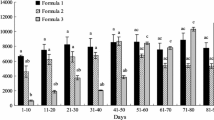Abstract
In the present studyChrysoperla carnea (Steph.) (Neuroptera, Chrysopidae)-eggs with and without stalk were compared. The eggs stem from stock breeds either fed with a semisynthetic diet (Bionova breed) or with aphids (Institute breed). The comparison is done with the use of the parameter hatching rate of the larvae and with parameters of the following larval and pupal development. The experiments were conducted in a climatic chamber under defined conditions. The individuums of the egg and the following development stages were each kept in little petri dishes.
The results of the experiments exhibit that the hatching rate of those larvae which originate from both variants of the Bionova breed, where the eggs were seperated from the stalk, was clearly lower (60% and 62%) than that one of the other variants (78, 84 and 86%). The larvae, which stem from eggs with stalk maintained at the institute developed within 19.9 days which is significantly longer than the development time of the other variants. The larvae of the same breed but destalked required 16.9 days to reach the pupal stage. The development times of the 3 variants of the Bionova breed were 16.6, 16.1 and 15.8 days respectively.
The mortality rate was highest (50%) for those larvae of the Bionova breed, which stem from eggs without stalk. In contrast to this the mortality of the other variants varied between 25.6 and 35.5%.
The duration of the pupal stage for individuals that originate from the Institute breed was significantly longer (16.2 and 16.5 days) than that one for individuals of the Bionova breed 13.5 and 13.8 days). The other variants had no influence on the duration of the pupal stage.
Zusammenfassung
In der vorliegenden Arbeit wurdenC. carnea-Eier mit und ohne Stielchen verglichen, die entweder aus einer mit semisynthetischer Diät oder aus einer mit Blattläusen ernährten Zucht stammten. Als wichtigste Parameter dienten dabei die Ermittlung der Schlupfrate der Larven sowie deren weitere Larval- und Pupalentwicklung. Die Versuche erfolgten in Klimaschränken unter definierten Bedingungen bei Einzelhaltung der Eier und der weiteren Entwicklungsstadien vonC. carnea in kleinen Petrischalen.
Die Ergebnisse zeigten, daß die Schlupfrate der Larven aus beiden Varianten der Zucht Bionova, bei deren Eiern das Stielchen abgetrennt worden war, mit 60 bzw. 62% deutlich niedriger lag als bei denen der anderen Varianten mit 78, 84 und 86%. Die Larven, deren Eier aus der Institutszucht stammten und die mit Stiel belassen wurden, wiesen mit 19,9 Tagen eine signifikant längere Entwicklungsdauer auf als die der anderen Varianten. Die Larven derselben Zucht aus der Variante „ohne Stiel” benötigten 16,9 Tage zum Erreichen des Puppenstadiums, während die Larven der Varianten aus der Zucht Bionova sich nach 16,6, 16,1 und 15,8 Tagen verpuppten. Die höchste Mortalitätsrate von 50% konnte bei den Larven aus der Zucht Bionova festgestellt werden, deren Eier stiellos waren. Dagegen schwankte die Mortalität in den anderen Varianten zwischen 25,6 und 35,5%.
Die Dauer der Puppenruhe war bei den Individuen aus der Zucht des Instituts mit 16,2 und 16,5 Tagen ungeachtet der verschiedenen Varianten signifikant länger als bei denen aus der Zucht Bionova. Die Puppen der Varianten aus der Zucht Bionova verblieben zwischen 13,5 und 13,8 Tage im Puppenstadium.
Similar content being viewed by others
Literaturverzeichnis
Butler, G. D. Jr.;Ritchie, P. L., 1970: Development ofChrysopa carnea at constant and fluctuating temperatures. J. Econ. Ent.63, 1028–1030.
Frings, B.;Şengonca, Ç., 1988: Untersuchungen über die Anwendungsmöglichkeiten von Florfliegenhäuschen im Freiland. Mitt. Dtsch. Ges. Allg. Angew. Ent. (Giessen)6, 233–237.
Hassan, S. A., 1978: Releases ofChrysopa carnea Steph. to controlMyzus persicae (Sulzer) on eggplant in small greenhouse plots. Z. Pflanzenkrankh. Pflanzensch.85, 118–123.
Kole, M;Van Lenteren, J. C.;Van Vliet, G. J. C. M., 1985: Integrated pest management in the greenhouse of the botanical garden of Leiden university, the Netherlands. Med. Fac. Landbouww. Rijksuniv. Gent,50/2a, 403–409.
Morrison, R. K., 1985:Chrysopa carnea. InSingh, P. andR. F. Moore (Eds.), Handbook of insect rearing. Elsevier Sc. Publ. B.V., The Netherlands. pp. 419–426.
Şengonca, Ç.;Coeppicus, S., 1985: Fraßaktivität vonChrysoperla carnea (Stephens) gegenüberTetranychus urticae Koch. Z. ang. Zool.72, 335–342.
Şengonca, Ç.;Grooterhorst, A., 1985: The feeding activity ofChrysoperla carnea (Stephens) onBarathra brassicae L. andSpodoptera littoralis (Boisd.). Z. ang. Ent.100, 219–223.
Şengonca, Ç.;Gerlach, S.;Melzer, G., 1987: Einfluß der Ernährung mit unterschiedlicher Beute aufChrysoperla carnea (Stephens) (Neuroptera: Chrysopidae). Z. Pflanzenkrankh. Pflanzensch.94, 197–205.
Sundby, R. A., 1966: A comparative study of the efficiency of three predatory insectsCoccinella septempunctata L. (Coleoptera, Coccinellidae),Chrysopa carnea St. (Neuroptera, Chysopidae) andSyrphus ribesii L. (Diptera, Syrphidae) at two different temperatures. Entomophaga2, 395–404.
Yakti, R.;Poehling, H.-M., 1988: Effizienz von Blattlausprädatoren (Coccinelliden- und Chrysopiden-Larven) und einem Insektenwachstumsregulator (JHA) gegenüberAphis fabae Scop. (Homoptera, Aphididae) an resistenten und anfälligen Sorten vonVicia faba (L.). Mitt. Dtsch. Ges. Allg. Angew. Ent.6, 37–43.
Author information
Authors and Affiliations
Additional information
Mit einer Abbildung und 2 Tabellen
Rights and permissions
About this article
Cite this article
Şengonca, Ç., Schimmel, C. Ein Vergleich vonChrysoperla carnea (Steph.)-Eiern mit und ohne Stielchen aus einer mit semisynthetischer Diät sowie aus einer mit Blattläusen ernährten Zucht im Hinblick auf einen Freilandeinsatz. Anz. Schadlingskde., Pflanzenschutz, Umweltschutz 66, 81–84 (1993). https://doi.org/10.1007/BF01906816
Issue Date:
DOI: https://doi.org/10.1007/BF01906816




